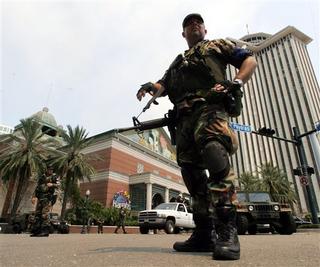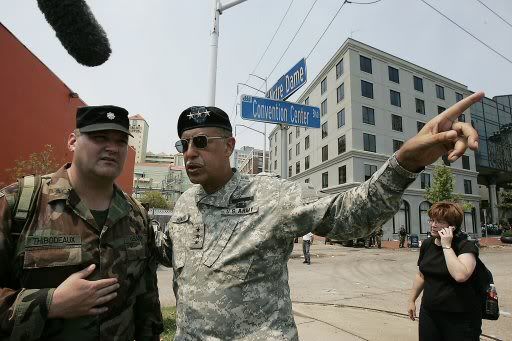KATRINA / National Guard have shoot-to-kill orders to deal with armed gangs

Police are avoiding duty as bullet-riddled bodies come to light
THOUSANDS of National Guardsmen poured into New Orleans yesterday with shoot-to-kill orders as armed gangs continued to terrorise a city awash with rotting bodies and toxic waste.
Still in the city, too, were tens of thousands of dehydrated and desperate residents and flooded hospitals, which reported scores of deaths on wards with no electricity or medicine.
Ray Nagin, the city’s mayor, said conditions were appalling and getting worse, and gave warning of thousands more deaths. “The people of our city are holding on by a thread. Time has run out. Can we survive another night? Only God knows.”
After a night in which police stations and hospitals came under sniper fire, the estimated 40,000 people still stranded in New Orleans — most without food or water for three days — were rocked by an explosion at a chemical depot a mile from the centre. Throughout the day, an acrid grey cloud covered the city, adding to the post-apocalyptic scene.
Bodies began rotting on main streets, gunmen continued to fire on troops and rescue helicopters, and police officials said that many officers had stopped reporting for duty, cutting manpower by 20 per cent.
 One New Orleans police officer wept as he described seeing bodies riddled with bullets, and the top of one man’s head shot off. He said some looters were armed with AK47 rifles, and compared the situation with Somalia, with police outnumbered and outgunned by gangs in trucks. “It’s a war-zone, and they’re not treating it like one,” he said, referring to the federal Government.
One New Orleans police officer wept as he described seeing bodies riddled with bullets, and the top of one man’s head shot off. He said some looters were armed with AK47 rifles, and compared the situation with Somalia, with police outnumbered and outgunned by gangs in trucks. “It’s a war-zone, and they’re not treating it like one,” he said, referring to the federal Government.
Michael Brown, head of the Federal Emergency Management Agency, said: “We are working under conditions of urban warfare.”
Mike Leavitt, the Health Secretary, acknowledging that thousands of people were living among excrement, without food or water, said: “We have a recipe for disease.”
Alan Gould, waiting to be evacuated, said: “We’ve got small children and sick and elderly people dying every day, small children being raped and killed, people running around with guns. I’m scared for my life, my wife and my five-year-old daughter’s life.”
Many expressed anger and incredulity that it had taken nearly five days to get troops on the ground, and the city’s officials lambasted President Bush for what they called a woefully slow and inadequate response. A growing political crisis for Mr Bush was aggravated by Dennis Hastert, the Republican Speaker in the House of Representatives, who said that it was a waste of money to rebuild New Orleans because it sat below sea level. “It looks like a lot of that place could be bulldozed,” he told a newspaper in Illinois. He later retracted his comments.
The Pentagon said that 14,000 National Guard troops were on the ground along the Gulf Coast, with 30,000 expected in coming days. “These troops are battle-tested. They have M16s and are locked and loaded,” Kathleen Blanco, the Governor of Louisiana, said.


Lieutenant-General Steven Blum, of the National Guard, said the 7,000 guardsmen arriving in Louisiana would be dedicated to restoring order to New Orleans. He said half of them had just returned from overseas assignments and were “highly proficient in the use of lethal force”. He pledged to “put down” the violence “in a quick and efficient manner”.
Although thousands were evacuated to the Houston Astrodome sports arena, another 30,000 refugees remained in the fetid and body-strewn New Orleans convention centre. Soldiers began to arrive at lunchtime, bringing food and water.
An effort to evacuate patients and staff from Charity Hospital, in the city centre, was suspended after it came under sniper fire. In other hospitals, doctors worked around the clock to keep patients alive without oxygen, insulin and other medicines. Some patients died in parking lots as they waited to be taken to helicopters.
At the city’s airport, a field hospital was overwhelmed by patients. Conveyor belts normally used to move luggage were instead ferrying the sick to a treatment centre and to aircraft and buses for evacuation.
“I do not have the words in my vocabulary to describe what is happening here,” Ozro Henderson, a medical team commander, said. “Catastrophe and disaster don’t tell it.” [The Times]
THOUSANDS of National Guardsmen poured into New Orleans yesterday with shoot-to-kill orders as armed gangs continued to terrorise a city awash with rotting bodies and toxic waste.
Still in the city, too, were tens of thousands of dehydrated and desperate residents and flooded hospitals, which reported scores of deaths on wards with no electricity or medicine.
Ray Nagin, the city’s mayor, said conditions were appalling and getting worse, and gave warning of thousands more deaths. “The people of our city are holding on by a thread. Time has run out. Can we survive another night? Only God knows.”
After a night in which police stations and hospitals came under sniper fire, the estimated 40,000 people still stranded in New Orleans — most without food or water for three days — were rocked by an explosion at a chemical depot a mile from the centre. Throughout the day, an acrid grey cloud covered the city, adding to the post-apocalyptic scene.
Bodies began rotting on main streets, gunmen continued to fire on troops and rescue helicopters, and police officials said that many officers had stopped reporting for duty, cutting manpower by 20 per cent.
 One New Orleans police officer wept as he described seeing bodies riddled with bullets, and the top of one man’s head shot off. He said some looters were armed with AK47 rifles, and compared the situation with Somalia, with police outnumbered and outgunned by gangs in trucks. “It’s a war-zone, and they’re not treating it like one,” he said, referring to the federal Government.
One New Orleans police officer wept as he described seeing bodies riddled with bullets, and the top of one man’s head shot off. He said some looters were armed with AK47 rifles, and compared the situation with Somalia, with police outnumbered and outgunned by gangs in trucks. “It’s a war-zone, and they’re not treating it like one,” he said, referring to the federal Government.Michael Brown, head of the Federal Emergency Management Agency, said: “We are working under conditions of urban warfare.”
Mike Leavitt, the Health Secretary, acknowledging that thousands of people were living among excrement, without food or water, said: “We have a recipe for disease.”
Alan Gould, waiting to be evacuated, said: “We’ve got small children and sick and elderly people dying every day, small children being raped and killed, people running around with guns. I’m scared for my life, my wife and my five-year-old daughter’s life.”
Many expressed anger and incredulity that it had taken nearly five days to get troops on the ground, and the city’s officials lambasted President Bush for what they called a woefully slow and inadequate response. A growing political crisis for Mr Bush was aggravated by Dennis Hastert, the Republican Speaker in the House of Representatives, who said that it was a waste of money to rebuild New Orleans because it sat below sea level. “It looks like a lot of that place could be bulldozed,” he told a newspaper in Illinois. He later retracted his comments.
The Pentagon said that 14,000 National Guard troops were on the ground along the Gulf Coast, with 30,000 expected in coming days. “These troops are battle-tested. They have M16s and are locked and loaded,” Kathleen Blanco, the Governor of Louisiana, said.


Lieutenant-General Steven Blum, of the National Guard, said the 7,000 guardsmen arriving in Louisiana would be dedicated to restoring order to New Orleans. He said half of them had just returned from overseas assignments and were “highly proficient in the use of lethal force”. He pledged to “put down” the violence “in a quick and efficient manner”.
Although thousands were evacuated to the Houston Astrodome sports arena, another 30,000 refugees remained in the fetid and body-strewn New Orleans convention centre. Soldiers began to arrive at lunchtime, bringing food and water.
An effort to evacuate patients and staff from Charity Hospital, in the city centre, was suspended after it came under sniper fire. In other hospitals, doctors worked around the clock to keep patients alive without oxygen, insulin and other medicines. Some patients died in parking lots as they waited to be taken to helicopters.
At the city’s airport, a field hospital was overwhelmed by patients. Conveyor belts normally used to move luggage were instead ferrying the sick to a treatment centre and to aircraft and buses for evacuation.
“I do not have the words in my vocabulary to describe what is happening here,” Ozro Henderson, a medical team commander, said. “Catastrophe and disaster don’t tell it.” [The Times]

<< Home